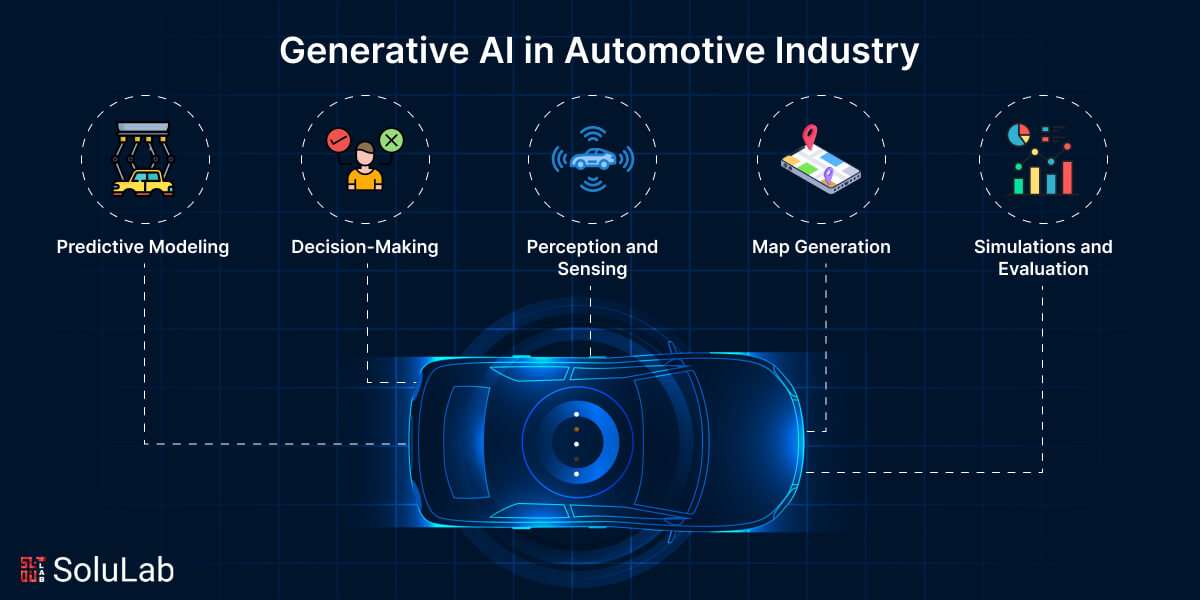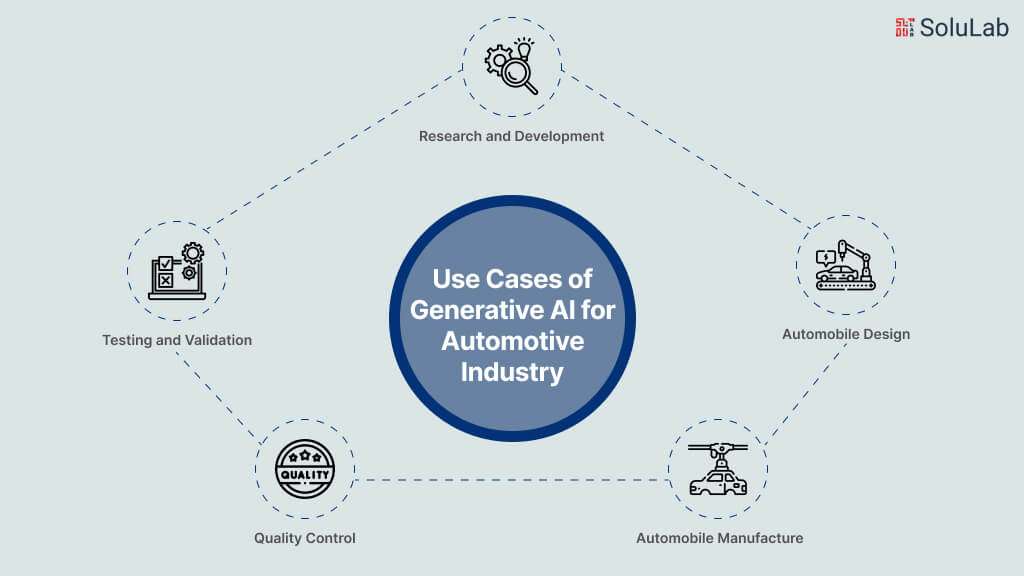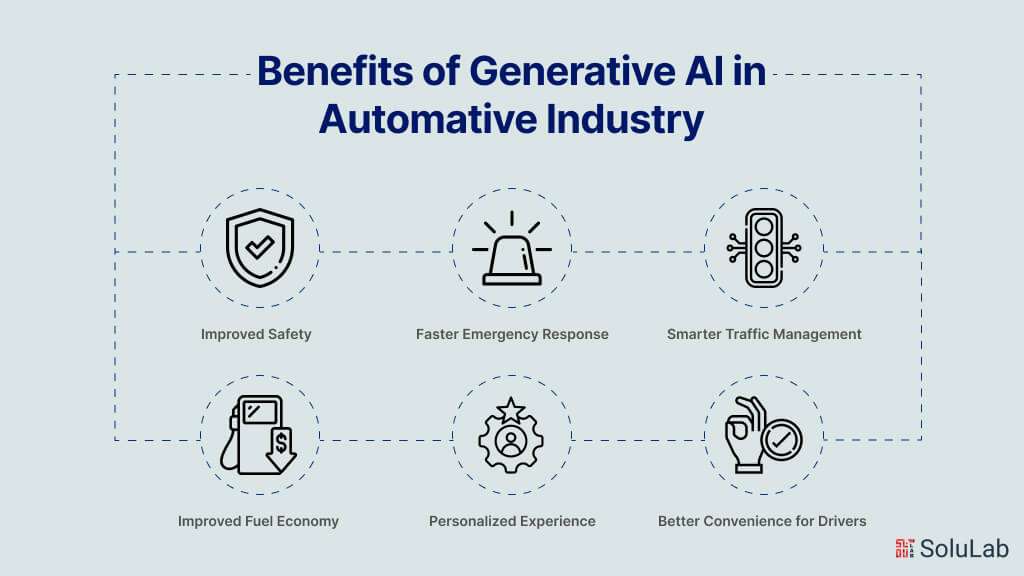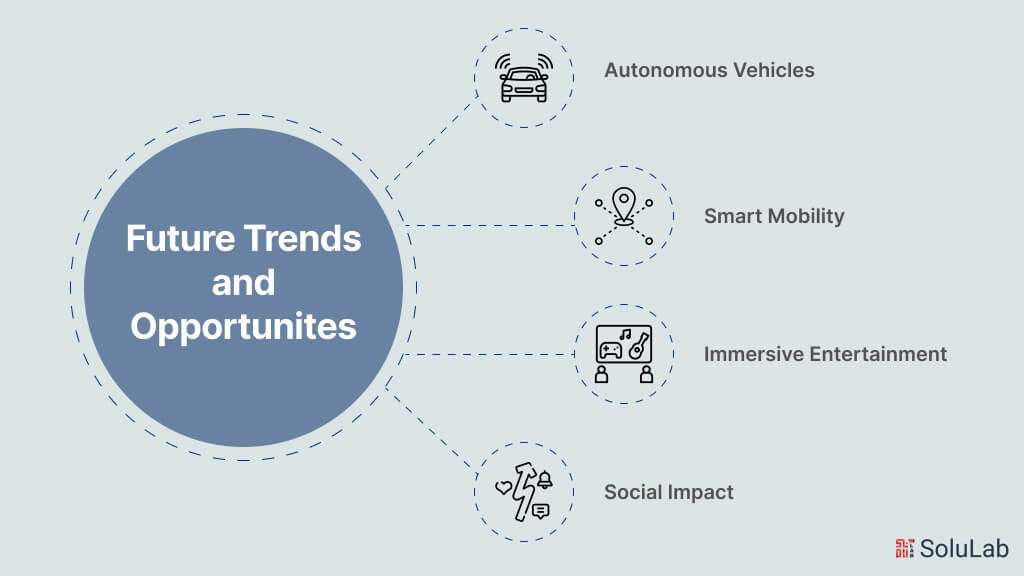
Generative AI alters the automotive environment by instilling intelligence in vehicles and generating tailored driving experiences that respond to individual interests and requirements. The age of rigid and conventional interfaces is over; these cars may now modify their aesthetics, displays, and controls, providing a fully personalized driving experience perfectly aligned with the user’s needs.
Furthermore, generative AI in automotive industry is propelling us towards a safer and more intuitive driving experience. Vehicles that include generative AI continually learn from drivers’ behavior, enabling their driving aid systems to change accordingly. This results in a smart co-pilot that provides real-time safety support and tailors its strategies to individual driving techniques and habits.
Beyond customization, generative AI has exciting prospects for building environmentally conscientious autos. This technology improves numerous areas of a vehicle’s performance, particularly power efficiency, opening the door for greener engineering and supporting sustainable transportation alternatives. According to Precedence Research, the worldwide market for generative AI in automotive industry is expected to reach USD 312.46 million by 2022. Projections show that it will reach around USD 2,691.92 million by 2032, representing a phenomenal CAGR of 24.03% from 2023 to 2032.
In this article, we will look at the impact of generative AI for automotive industry, including its applications, advantages, future trends, and real-world instances. So, without any further ado, let’s get started!
Read Also: Top Generative AI Development Companies
Basics of Generative AI
Generative AI is a branch of AI that emphasizes developing algorithms that can produce fresh and original content. Despite typical AI systems developed for specific tasks, generative AI seeks to replicate human creativity by acquiring patterns and structures from current data and producing wholly new outputs with exceptional originality, such as videos, photos, music, text, and codes.
Whereas supervised learning, relies on labeled data for training, generative AI runs independently and without human intervention. Instead, it explores deeply into datasets, automatically identifying detailed patterns and structures. The core of generative AI is its capacity to turn newly acquired information into wholly new and creative material, hence opening up a universe of possibilities.
Generative Adversarial Networks (GANs) are among the most prominent generative AI techniques, consisting of two neural networks: a generator and a discriminator. The generator creates data, whereas the discriminator separates genuine from fake data. GANs generate extremely realistic and creative material as a result of this adversarial process, resulting in effective tools for picture synthesis, text generation, and other tasks.
Generative AI offers a wide range of applications, including picture and video synthesis, text production, music composition, and art development. It can influence creativity by pushing the frontiers of what AI is capable of, opening up intriguing possibilities for the future.
Application of Generative AI in Vehicle Automation
Generative AI’s in automobile is playing an important role in increasing automotive automation. It enables many key features of autonomous driving and vehicle automation:
- Perception and Sensing: Generative AI uses artificial intelligence and LiDAR technology to assist automobiles sense their surroundings. AI systems can create precise 3D maps of the surroundings, allowing cars to properly detect obstructions, people, and other vehicles.
- Decision-Making: Generative AI facilitates real-time decision-making for autonomous cars. These systems may simulate different driving scenarios and determine the best reactions to guarantee safe navigation, such as whether to stop, accelerate, or change lanes.
- Predictive Modeling: AI models employ generative approaches to forecast the actions of other road users, making autonomous cars better than ever at predicting and responding.
- Simulations and Evaluation: Generative AI creates massive volumes of synthetic data and actual circumstances to test autonomous car systems. This speeds up the development and certification process, making automobiles safer and more dependable.
- Map Generation: Generative AI is used to produce high-resolution maps, which are required for autonomous navigation. These maps feature details such as road conditions, lane markings, traffic signals, and more.
- Natural Language Systems: Some self-driving vehicles have conversational AI systems that permit passengers to engage with the vehicle in natural language, making the experience of driving more user-friendly.
- Robotic Vehicles: Generative AI is also utilized in autonomous delivery trucks and robots in a variety of sectors to improve their capacity to navigate difficult situations and complete jobs effectively.
Overall, generative AI in automative is important, allowing for safer, more effective, and trustworthy autonomous driving experiences.
Use Cases of Generative AI for Automotive Industry

Generative AI in the automotive sector has various use cases, such as those mentioned below:
-
Research and Development
GenAI plays an important role in research and development by evaluating large datasets to identify optimum materials, designs, and technologies. By utilizing complex algorithms, it helps engineers make data-driven decisions that improve vehicle safety and efficiency. This simplified strategy speeds up the innovation process by enabling the discovery of new concepts and advances in automotive design, ultimately leading to the construction of safer and more efficient automobiles.
Read Blog Post: Generative AI Use Cases
-
Automobile Design
Generative AI analyzes large datasets and simulates many design scenarios, quickly producing several design solutions for complicated automotive systems such as engines, lightweight structures, and car characteristics. This allows designers to explore new ideas, generating creative and inventive solutions.
For example, producing lifelike 3D automobile models with only a few parameters or drawings. This speeds up the design process, allowing designers to envision and improve their concepts more rapidly and effectively. Furthermore, generative AI’s capacity to generate and test different configurations and parameters can improve vehicle performance, safety, and efficiency, resulting in revolutionary advances in automotive technology.
-
Automobile Manufacture
Car makers have smoothly incorporated artificial intelligence into every part of the manufacturing process. AI in the automative sector enable robots to reliably pick items from conveyor belts. Using deep learning, these machines can autonomously choose which components to pick, how to pick them, and in what order, decreasing personnel needs and improving process accuracy.
For example, designing customized parts and components based on unique client preferences and specifications. Manufacturers may now give a variety of tailored alternatives, increasing client satisfaction. Furthermore, generative AI’s capacity to evaluate pictures and sensor data allows for the detection and correction of flaws and abnormalities in the production process, resulting in increased quality control and efficiency in automobile manufacturing.
-
Quality Control
Generative AI is transforming quality control in the automobile sector. Its capacity to evaluate massive volumes of data and find even minor flaws in produced components is crucial. Generative AI systems may analyze photos, sensor data, and even auditory signals to detect irregularities in components, guaranteeing that only high-quality parts enter automobiles. By automating this inspection process, generative AI not only increases problem identification accuracy but also saves time and money compared to manual quality control. This technology not only improves product quality but also contributes significantly to the Artificial Intelligence automotive industry’s safety requirements and the satisfaction of customers.
-
Testing and Validation
During the testing phase, autonomous cars are extensively evaluated in virtual settings that have been rigorously built and fine-tuned by artificial intelligence systems. These simulations replicate a variety of scenarios, from complicated traffic problems to harsh weather conditions, allowing the AI driving system to learn and adapt in a risk-free environment. This intensive testing guarantees that self-driving vehicles can traverse a variety of demanding conditions, which contributes to their safety and dependability on public roads. Based on the data gathered in these virtual settings, the AI continually improves its decision-making capabilities, making the car more prepared for a variety of driving circumstances.
How Can Generative AI Be Implemented in the Automobile Industry?
Implementing generative Artificial Intelligence in automotive industry necessitates a careful and strategic strategy to fully exploit the technology. Here’s a step-by-step plan of action for implementing generative AI for automotive business:
Define the Goals and Use Cases
- Define the goals you hope to achieve with generative AI. This might entail boosting design processes, optimizing production, increasing consumer experiences, or simplifying supply chain operations.
- Determine whether applications of generative AI in automative may provide considerable value, such as generative design for automotive components, predictive maintenance, natural language processing for client interactions, or supply chain optimization.
Data Collection and Preparation
- Collect high-quality, diversified datasets related to your selected use cases. This could involve data on vehicle performance, production procedures, consumer feedback, or supply chain logistics.
- Clean and preprocess the data to make it appropriate for training generative AI models. Data quality is critical to the efficacy of any AI project.
Choose the Relevant Generative AI Models
- Choose relevant generative AI models for your unique use cases. Generic models, including GPT (Generative Pre-trained Transformer), and custom generative models that utilize automobile data, should be investigated.
- Examine pre-trained models or train models on your own automotive datasets to confirm that the AI understands industry-specific peculiarities.
Integration & Development
- To deploy generative AI solutions, consider collaborating with an AI development business or hiring a qualified team. Check they have prior expertise dealing with automotive data and other particulars to the industry.
- Incorporate generative AI models into current systems or create new apps based on your goals. This might include integration with design tools, manufacturing procedures, customer service platforms as well as supply chain management systems.
Testing & Validation
- Test and validate generative AI models to guarantee accuracy and alignment with set objectives. Analyze their performance against key metrics and make any required changes.
- Validate the findings with real-world scenarios to ensure that the generative AI models are applicable in practice.
Read Blog Post: Generative AI for Compliance
Security & Compliance
- Optimize security measures for sensitive automotive data. Use encryption, access restrictions, and secure data transfer to ensure data integrity and privacy.
- Maintain compliance with Artificial Intelligence in automotive industry norms and standards, particularly given the sensitivity of automobile data.
Benefits of Generative AI in Automotive Industry

The benefits of applying generative AI in the automotive sector are:
- Improved Safety: The integration of AI technology has resulted in the creation of improved safety systems that alert drivers of possible risks, take proactive measures, and avoid tragic accidents, making roads safer for everyone.
- Faster Emergency Response: AI can improve emergency response time by automatically dispatching notifications to emergency services in the event of an accident.
- Smarter Traffic Management: Artificial intelligence can evaluate real-time traffic data to recommend other routes for emergency vehicles, minimizing crowded regions and reducing travel time to the accident scene.
- Improved Fuel Economy: By examining fuel consumption data, AI can help fleet managers find patterns and trends, enabling them to identify chances for better fuel efficiency. By analyzing characteristics such as vehicle speed, idle time, and route efficiency, AI can provide significant recommendations for cost savings and fuel efficiency.
- Personalized Experience: AI in-vehicle may use data from the driver’s previous actions, preferences, and requirements to provide a more personalized experience. Customizing music, navigation, climate settings, and other elements enhances the driving experience and tailors it to the particular driver.
- Better Convenience for Drivers: AI can improve driver efficiency by automating route planning, directions, and even autonomous driving capabilities. Drivers may rely on artificial intelligence-driven GPS and navigation systems for optimal route suggestions, instant traffic updates, and adaptive driving assistance, which frees up their focus and makes driving more convenient and stress-free.
Related: AI Agents in the Automotive Industry
Generative AI’s Influence at Various Levels of Vehicle Automation
The Society of Automotive Engineers (SAE) has developed a recognized classification of driving automation that includes six levels ranging from Level 0, which is entirely manual, to Level 5, which represents complete autonomy. These levels have been accepted by the United States Department of Transportation to provide a complete framework for measuring and comprehending the evolution of autonomous driving technology. According to SAE, the six levels of vehicle automation are:
Level 0: No Driving Automation
Most cars in service today are classified as Level 0 in terms of automation. At this level, the driver controls the car totally manually. Although various aid devices may be there to help the driver, they are not regarded as automation because the person is still accountable for the “dynamic driving task.”
Level 1: Driver Assistance
Level 1 automation is the first step towards vehicle autonomy. At this level, only one automated system for driver assistance is integrated into the vehicle’s operations, such as steering or acceleration, sometimes known as cruise control. The adaptive cruise control system is an example of Level 1 automation, which allows automobiles to stay at an appropriate distance to follow the car ahead. At this level, AI in the automative sector may be used to improve driver assistance capabilities. For example, it can improve lane-keeping assistance by identifying lane markers and aiding with lane centering. Still, the human driver continues to be liable for other critical parts of driving, including steering and braking, while simultaneously tracking the automated system’s functions.
Level 2: Partial Driving Automation
Advanced Driver Assistance Systems (ADAS) are introduced at level 2 automation, allowing the vehicle to deal with both steering and accelerating/decelerating operations. However, it is important to remember that this level comes short of complete self-driving abilities because a human driver remains in the driver’s seat and has the ability to take control of the vehicle at any time. Tesla Autopilot and Cadillac (General Motors) Super Cruise systems are notable instances of Level 2 automation since they demonstrate breakthroughs in vehicle technology while preserving the necessity for human supervision and intervention.
Level 3: Conditional Driving Automation
The move from Level 2 to Level 3 automation constitutes a considerable technological advancement, while the influence on the viewpoint of humans may appear minor, if not inconsequential. At level 3, cars have extensive “environmental detection” skills which enable them to make autonomous judgments, such as overtaking a slow-moving vehicle. However, they continue to depend on human intervention, requiring the driver to be attentive and prepared to take control if the system confronts obstacles beyond its capabilities.
Read Blog: Generative AI Automation
Level 4: High-driving Automation
The distinction between level 3 and level 4 automation is that level 4 vehicles can intervene in the event of a system breakdown without requiring ongoing human contact. While these vehicles may run autonomously, they are still limited to particular locations, mainly urban environs, with top speeds of roughly 25 kph due to geofencing restrictions. As a result, many level 4 vehicles, such as NAVYA’s totally electric shuttles and taxis, largely serve the ridesharing business in the United States. Generative AI trends can help to improve the dependability and robustness of Level 4 autonomous systems. AI in Automotive Industry may also be utilized to increase object detection and understanding, enabling the vehicle more competent in navigating changing traffic scenarios.
Level 5: Full Driving Automation
At level 5, cars no longer require human attention since the “dynamic driving task” has been abolished. These completely autonomous vehicles no longer require steering wheels or acceleration/braking pedals. Level 5 cars are free of geofencing constraints and may travel anywhere and do any driving duty, much like skilled human drivers. Generative models may be used to make decisions, plan routes, analyze complicated urban surroundings, and even simulate unusual and severe scenarios to assure the vehicle’s safety. Audi, Ford, BMW, Google, Tesla, General Motors, Volkswagen, and Volvo are among the automotive manufacturers researching and testing self-driving vehicles.
Future Trends and Opportunites in Generative AI for Automotive Industry

As generative AI progresses and becomes more accessible, it will open up new potential in the Artificial Intelligence automotive sector. Here are some future trends and circumstances where generative AI might make a huge impact:
- Autonomous Vehicles: Generative AI will be essential in the development of autonomous vehicles, allowing for the production and processing of massive volumes of data and pictures to train and enhance self-driving algorithms. It will allow autonomous cars to adapt to a variety of circumstances and surroundings using realistic simulations and scenarios.
- Smart Mobility: Generative AI will assist in developing smart mobility solutions that are more efficient, easy to use, and ecologically friendly. They can improve overall transportation efficiency by evaluating real-time data and making predictions about traffic flow and routing. They may offer customized and on-demand transportation services based on consumer profiles and choices.
- Immersive Entertainment: Generative AI has the potential to significantly improve the experience of entertainment for passengers and drivers by creating interactive and personalized material. Generative AI in automotive Industry can adjust experiences to users’ moods, preferences, and circumstances. Adaptive soundtracks and playlists can improve the driving experience.
- Social Impact: Generative AI will have a good social impact by tackling different automotive sector difficulties. It can help to reduce carbon emissions and environmental effects by developing and optimizing green cars. Furthermore, generative AI can improve road safety and accessibility by creating and refining safety measures and assistive technology.
The emergence of generative AI promises to transform Artificial Intelligence in automotive industry, ushering in a new age of inventive possibilities and long-term advances. As these technologies advance, coordination among AI developers, automakers, and legislators will be critical to ensuring safe and inclusive adoption for the benefit of society.
Concluding Remarks
Generative AI in the automotive sector has an influence on many elements of vehicle design, manufacture, maintenance, and user experience. Its capacity to evaluate historical data and real-time inputs from sensors has advanced vehicle development by allowing for more efficient simulations, resulting in cost savings and better performance. Generative AI’s predictive capabilities have had a substantial influence on maintenance operations, allowing for proactive repair planning and decreasing unexpected breakdowns, hence increasing fleet efficiency. Furthermore, patented voice assistants driven by generative AI provide tailored and intuitive features, adapting the driving experience to individual preferences while providing safer and more convenient travel for drivers. The Generative Artificial Intelligence automotive industry is expanding, promising a future full of creativity and enhanced mobility for customers worldwide.
SoluLab, a leading AI development company, is revolutionizing the automobile sector with its Generative AI capabilities. SoluLab helps automobile firms improve their design and production processes by using the latest innovations and employing a team of expert AI developers. SoluLab’s Generative AI enables organizations to develop creative solutions for car design, predictive maintenance, and autonomous driving systems. SoluLab’s personalized AI solutions enable efficiency and innovation in the AI in automotive industry, whether by enhancing vehicle performance or automating production procedures. Hire AI developers from SoluLab now to fully explore the potential of Generative AI in your automotive projects. Contact us now to begin your AI-powered path to automotive excellence.
FAQs
1. What is Generative AI, and how does it apply to the automotive industry?
Generative AI in automotive industry is a branch of artificial intelligence that focuses on creating new content, such as images, text, or even designs, that mimic human-like creativity. In the automotive industry, Generative AI can be utilized to generate innovative designs for vehicles, optimize manufacturing processes, and even aid in the development of autonomous driving systems.
2. How can Generative AI improve vehicle design and manufacturing processes?
Generative AI can significantly enhance vehicle design by quickly generating numerous design alternatives based on specific parameters, thus allowing designers to explore a wider range of options efficiently. Moreover, it can optimize manufacturing processes by generating layouts that maximize efficiency, minimize waste, and improve overall productivity.
3. What are the key challenges in implementing Generative AI solutions in the automotive sector?
Some key challenges in implementing Generative AI solutions in the automotive sector include data quality and quantity, computational resources required for training complex models, regulatory compliance, and integration with existing systems and processes. Overcoming these challenges often requires a multidisciplinary approach and collaboration between AI experts, automotive engineers, and domain specialists.
4. Can Generative AI be utilized for predictive maintenance and improving vehicle performance?
Yes, Generative AI can be leveraged for predictive maintenance by analyzing sensor data and historical maintenance records to predict when components are likely to fail. This proactive approach helps minimize downtime and reduces maintenance costs. Additionally, Generative AI can optimize vehicle performance by generating personalized driving profiles, improving fuel efficiency, and enhancing overall driving experience.
5. How does SoluLab contribute to the advancement of Generative AI in the automotive industry, and what specific services do they offer?
SoluLab is at the forefront of advancing Generative AI in the automotive industry by offering tailored AI solutions to address various challenges and opportunities. Our services include developing custom Generative AI models for vehicle design optimization, manufacturing process improvement, predictive maintenance, and autonomous driving systems. With a team of skilled generative AI developers and domain experts, SoluLab ensures that our solutions are aligned with the specific needs and goals of automotive companies, driving innovation and efficiency in the industry.






